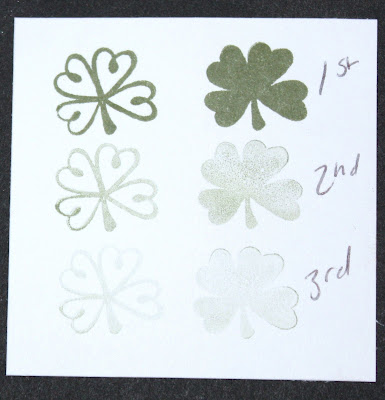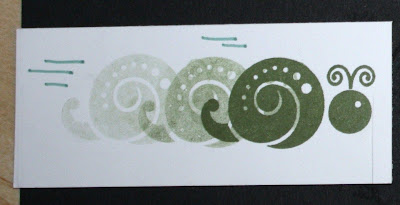*gives your image extra texture and depth to your image, while keeping the images clean layout on your page or card.
*layer your stamps (for ground and back ground)
*make different parts of you stamps different colors
*Take out parts of your stamps you don’t want
Basic Masking:
1) Stamp your image onto your cardstock.
2) Ink image again (if using outline and filler images just pick one) and stamp on to a sticky note.
*be sure to stamp towards the top of the sticky so that the sticky will be on the back of your image.
3) Cut around sticky note stamped image (as closely to the image as possible). This is your “mask”.
4) Position mask over stamped image. The sticky will help keep it in place.
5) Stamp background images over mask . (in this case the leaves). The ctmh clear stamps makes placing the background image easy!
6) Remove mask to reveal layered images.
The leaves are now behind the flower.
*note – if you don’t use a sticky note, be sure to use light weight paper instead of cardstock for the mask.
Reverse masking:
1) Stamp the entire image on a sticky note or thin paper.
2) Carefully cut away the portion you don’t need. This becomes the mask.
3) Lay the mask on your project. Ink the stamp and stamp it directly on the mask, matching up the cut-out image.
4) Fill in the extra space you created with another stamped image or accent.
Reverse masking for different colors:
1) Using either a sticky note or thin paper, stamp your image onto the mask paper. (stamp the image as many times as the number of colors you will be using). Ie – snail – green and pink, so stamp the image twice.
2) On one of the images cut out the part of your image you want to be one color. (i.e. the turtles shell)
3) On the next image cut out the other part on the other stamped mask. (i.e. the turtles legs, tail, and head)
4) Place one mask over the area you want your image. (ie – the mask with the shell cut out). Ink the image in the color desired (ie- pink) and stamp your image over the mask. (only the pink shell comes through onto your project)
**looking throught the ctmh clear stamp and block, it is easy to line up your image.
5) Place the next mask over the stamped image on your project (ie – place the mask with the open legs, tail, and head over the shell). Ink and stamp your image over the mask (ie – ink with green and the legs, tail, and head go next to the shell)
Sample card*** When grouping flowers you may have to make 2 masks for each flower.
Reverse Masking for sponging or shading:
1) Stamp the image onto thin paper. If you will be sponging different areas different colors, stamp image for each number of colors. IE – pumpkin base and pumpkin steam will be two different colors. Stamp the pumpkin twice.
2) Cut out the portion of the image you will be sponging or shading. IE – one one cut out the steam, on the other image the base. This is your mask.
3) Position mask over the image on your project and shade in the space. This creates a crisp shaded image.
**NOTE: This took a lot of time. If you are into shading and blending colors, it might be worth it. If you just want to color the inside of your stamped image I recommend using the blending pen or watercolor pencils. : )
Words:
*use the reverse technique to make words different colors.
step 1) Stamp onto a regular (non cardstock) piece of paper. For each color you want your stamp in, stamp that many times. In this picture I have 5 different colors (don't forget to include the black)- so I stamped it 5 times.
step 2) pick a color for each stamped part and cut out the phrase or words you want in that color.
Continue for each color
step 3) align the first phrased section as desired and stamp with the color for that phrase/word. Then continue with each phrase/word in their colors. Be sure to wash and dry the stamp inbetween each color!!
**You can also use this technique to move words into a different shape then the stamp. IE – you have a stamp set that looks like this:
I AM SO BLESSED TO HAVE YOU
AS A FRIEND!
Use the mask technique to make it look like this:
I AM SO
BLESSED
TO HAVE
YOU AS
A FRIEND!
For example:
Notice my quote on this page:
I wanted to fit the two lined phrase stamp into a circle shape. Also I wanted the words Knight and Mine to stand out.
Here is a picture of the paper I used to do this:
I cut out the sections that I wanted together in the circle. Also I cut out the words I wanted to be a different color. I traced the circle onto my cardstock. Then I lined up each section as I went and stamped with the desired color.
I know this takes a little more time. But if you want to make your pages ( or eve just your extra special pages) look a little more professional then this will be worth it to you! It is to me!
Some more samples of this technique:
It's easier to cut out these leaves only once or twice for a mask - then to cut out three or four stamped ones and try to arange them.
It was MUCH easier to cut out the balloon two times for a mask ( and one for reverse mask) then to cut out 20 tiny ballons and try gluing those on!
This card was REALLY EASY!! I only had to cut out 1 butterfly mask to cover the one over lapping butterfly. Also this was the card we made at the gathering - along with the turtle and yellow daisies at the top!















































